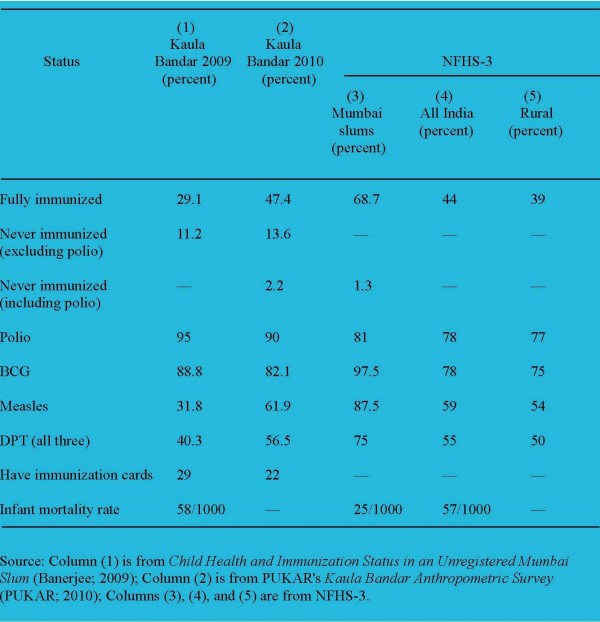Child Immunizations
On 12 September 1978, delegates at the WHO’s International Conference on Primary Health Care in Alma Ata, Kazakhstan, drafted the WHO’s goal of “health for all the people of the world by the year 2000.” The Declaration of Alma Atathat defines health as a fundamental human right, states that primary health care “includes at least […] immunization against the major infectious diseases,” (WHO; 1978).
In 2006, the National Family Health Survey (NFHS) reported that 70 percent of children in Mumbai city as a whole and 69 percent of children in Mumbai slums were fully immunized (Gupta et al; 2006). In sharp contrast, a 2009 sub study by Harvard School of Public Health student Joya Banerjee in collaboration with PUKAR research coordinator Tejal Shitole found that only 29 percent of children were fully immunized in Kaula Bandar (KB), an unregistered slum in Mumbai (Banerjee; 2009). Despite being a mere fifteen minutes away from the Bombay Stock Exchange, the country’s financial hub, the study found that Kaula Bandar lagged behind in several important health indicators, sometimes comparable or even worse than parts of rural India. By surveying over two hundred households, Banerjee and Shitole’s study explored the under five immunization rates in the community and examined the relationship between immunization status and child mortality.
The study had several notable findings. Most importantly, as a result of the lack of access to medical facilities in rural areas, children who were born in a village hospital or at home were 2.3 times less likely to be fully immunized (Banerjee; 2009). A later sub-study in collaboration with PUKAR by HSPH student Laura Khan explored pre-delivery maternal migration in Kaula Bandar. The study also found that when compared to women who were employed, those who were full-time homemakers were twice as likely to have fully immunized children. Interestingly, the study found little or no correlation between income, education, and immunization status (Banerjee; 2009). Banerjee and Shitole also found that a child who had been fully immunized was over three times more likely to survive till the age of five than a child who had not (Banerjee; 2009).
As a follow-up to the 2009 study, PUKAR carried out a nine month Biometrics study in 2010. This study had a sample of almost six thousand respondents that included more than 900 children under the age of five (PUKAR; 2010). The study was one of the first in-depth exploration of the anthropometrics of an unregistered slum covering all age groups. Researchers from the community collected the height, weight, head circumference, blood pressure, and immunization history of the sample.
The second study found an immunization rate of about 47 percent in Kaula Bandar. However, given that only 22 percent of respondents had vaccination cards, the rate in general was thought to be over reported as a result of the stigma associated with having a child who was not fully vaccinated (PUKAR; 2010). Either way, the immunization rates of both surveys place Kaula Bandar much lower than the average immunization rate for Mumbai.
In response to these indicators of low immunization, PUKAR has been exploring a range of strategies to deal with the problem. A key strategy has been to involve the community by raising awareness about correct immunization practices through posters and interpersonal communication. Another crucial strategy has been to involve the State health machinery, the Municipal Corporation of Greater Mumbai (MCGM), by sharing the results of the study and advocating collaborative interventions. For instance, following the studies, PUKAR held a series of meetings with the MCGM that involved sharing findings and extensively championing outreach in Kaula Bandar. As a result of this effort, the MCGM now organizes twice monthly health camps in Kaula Bandar. At these camps, in addition to consultation, immunization services are also provided. In fact, between February and July 2011, there were 564 immunization visits to these health camps. “Doctors are now a free service. And they come every month,” said Shakira Mulla, a resident of Kaula Bandar and one of PUKAR’s community researchers.
“ After the health camps, so many people have started to take medicines in the case of serious diseases. Earlier, they didn’t want to go outside their community. So many more children are immunized at the right age, and so many more households have immunization cards” —Shrutika Shitole, PUKAR research coordinator
PUKAR facilitates community participation in the camps through consistent house-to-house follow-up. “Now the MCGM is really working for the community. The government is for the people not for any particular piece of land. In Kaula Bandar now there are more than 300 or 400 children who are fully immunized,” said Kiran Sawant, research coordinator at PUKAR. He continued, “I feel proud because I helped to save 400 lives.” Through these sustained participatory initiatives that integrate research with intervention, PUKAR hopes to achieve its long-term goal of transforming Kaula Bandar into a community with the highest immunization rate in Mumbai.
References:
Banerjee, Joya. 2010. “Child Health and Immunization Status in an Unregistered Mumbai Slum.” Master’s Thesis for the Harvard School of Public Health. Boston: Unpublished.
Gupta, Kamla, Fred Arnold, and Lhungdim H. 2006. “Health and Living Conditions in Eight Indian Cities.” Based on NFHS-3 2005-06. Mumbai: International Institute for Population Studies,
PUKAR. 2010. “Kaula Bandar Anthropometric Survey.” Mumbai: Unpublished.
World Health Organization. 1978.“Declaration of Alma Ata.” Geneva: World Health Organization.
–
Resources:
Abstract of Child Health and Immunization Status in an Unregistered Mumbai Slum by Joya Banerjee. Please contact Joya Banerjee for a copy of the full thesis at joya.banerjee@gmail.com.
PUKAR’s educational handouts and posters on immunization Poster 1 and Poster 2
***An abstract from this project was accepted for oral presentation by HSPH student Joya Banerjee at the 2010 International Conference on Urban Health in New York, NY: View Abstract|

